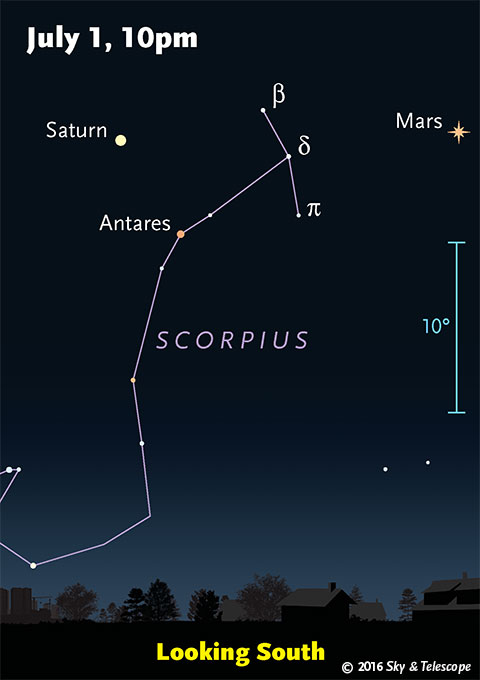
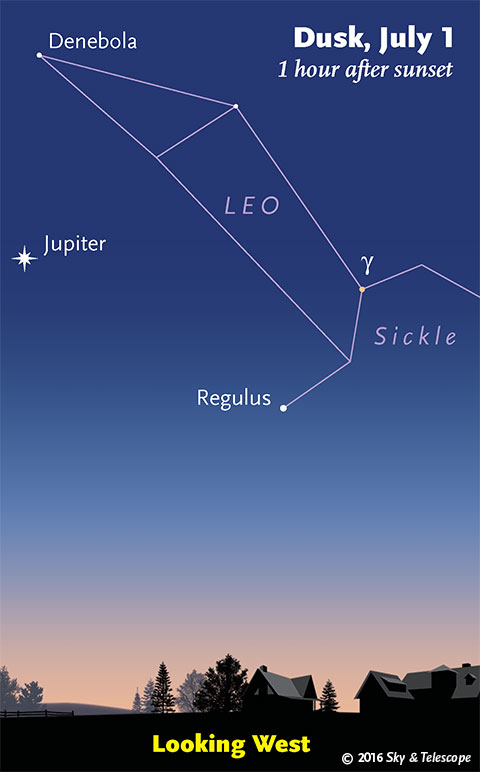
Friday, July 1
• Is your sky dark enough for you to see the Coma Berenices star cluster naked-eye? Just after the very end of twilight this week, spot Jupiter in the west. The cluster is above it by 25°, about 2½ fists at arm's length.
Its brightest members form an inverted Y. The entire cluster is about 5° wide — a big, dim glow in a truly dark sky. It nearly fills a binocular view.
Saturday, July 2
• If you have a dark sky, the Milky Way now forms a magnificent arch across the east. It runs all the way from below Cassiopeia in the north-northeast, up and across Cygnus and the Summer Triangle in the east, and down past the spout of the Sagittarius Teapot in the south.
Sunday, July 3
• Three doubles at the top Scorpius. The head of Scorpius — the near-vertical row of three stars upper right of Antares — stands to Saturn's right by about a fist at arm's length, as shown above. The top star of the row is Beta (ß) Scorpii or Graffias, a fine double star for telescopes.
Just 1° below it (and a little too faint for the chart above) is the very wide naked-eye pair Omega1 and Omega2 Scorpii, not quite vertical. Binoculars show their slight color difference.
Left of Beta by 1.6° is Nu Scorpii, another fine telescopic double. High power in good seeing reveals Nu's brighter component itself to be a close binary, separation 2 arcseconds.
Monday, July 4
• New Moon (exact at 7:01 a.m. EDT).
• More binary bounty! After dark, Vega is the brightest star very high in the east. Barely lower left of it is 4th-magnitude Epsilon (ε) Lyrae, the Double-Double. It forms one corner of a roughly equilateral triangle with Vega and Zeta (ζ) Lyrae. The triangle is less than 2° on a side, hardly the width of your thumb at arm's length.
Binoculars easily resolve Epsilon. And a 4-inch telescope at 100× or more should resolve each of Epsilon's wide components into a tight pair.
Zeta Lyrae is also a double star for binoculars; much tougher, but plainly resolved in any telescope. Delta (δ) Lyrae, below Zeta, is much wider and easier.
• Earth is at aphelion, its farthest from the Sun for the year (3% farther than at perihelion in January).
Tuesday, July 5
• Arcturus is the brightest star high in the west. Equally bright Vega is similarly high in the east. A third of the way from Arcturus to Vega, look for dim Corona Borealis, the Northern Crown, with its one modestly bright star, Gemma or Alphecca. Two thirds of the way, you'll find the dim Keystone of Hercules.
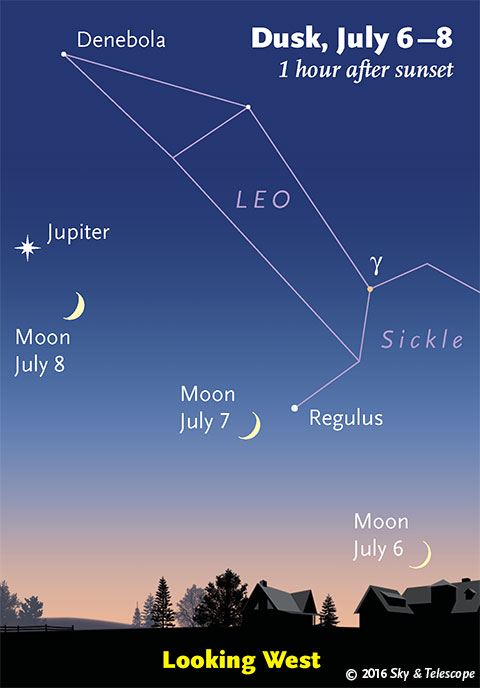
Wednesday, July 6
• Can you see the thin crescent Moon yet, low in the west in twilight? Jupiter and Regulus point the way, more or less, as shown at right.
• As evening grows late, even the lowest star of the Summer Triangle climbs high in the east. That's Altair, a good three or four fists at arm's length below or lower right of Vega.
Inside the Summer Triangle, near the line from Vega to Altair, is the grand double star Albireo, 2nd magnitude. But do you know about the "false Albireo" in the same binocular field? It consists of Alpha and 8 Vulpeculae, a wider pair that's also orange and blue. See Mathew Wedel's Binocular Highlight in the July Sky & Telescope, page 43.
Thursday, July 7
• The thin waxing crescent Moon hangs low in the west at dusk. Look for Regulus about 3° to its right or upper right, as shown above. Much farther to their upper left is Jupiter.
Friday, July 8
• The waxing crescent Moon shines in the west at dusk. Jupiter shines some 3° or 4° upper left of it for North America. As night comes on, look for Sigma Leonis, magnitude 4.0, glimmering 0.9° to Jupiter's upper left (not shown on the twilight chart above).
Saturday, July 9
• Jupiter now shines lower right of the Moon during and after dusk.
_________________________
Want to become a better astronomer? Learn your way around the constellations. They're the key to locating everything fainter and deeper to hunt with binoculars or a telescope.
This is an outdoor nature hobby. For an easy-to-use constellation guide covering the whole evening sky, use the big monthly map in the center of each issue of Sky & Telescope, the essential guide to astronomy.
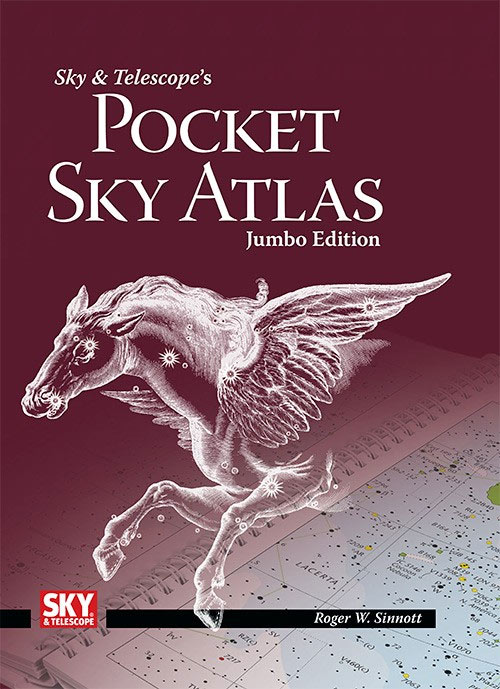
Once you get a telescope, to put it to good use you'll need a detailed, large-scale sky atlas (set of charts). The basic standard is the Pocket Sky Atlas (in either the original or new Jumbo Edition), which shows stars to magnitude 7.6.
Next up is the larger and deeper Sky Atlas 2000.0, plotting stars to magnitude 8.5, nearly three times as many. The next up, once you know your way around, is the even larger Uranometria 2000.0 (stars to magnitude 9.75). And read how to use sky charts with a telescope.
You'll also want a good deep-sky guidebook, such as Sue French's Deep-Sky Wonders collection (which includes its own charts), Sky Atlas 2000.0 Companion by Strong and Sinnott, or the bigger Night Sky Observer's Guide by Kepple and Sanner.
Can a computerized telescope replace charts? Not for beginners, I don't think, and not on mounts and tripods that are less than top-quality mechanically (meaning heavy and expensive). And as Terence Dickinson and Alan Dyer say in their Backyard Astronomer's Guide, "A full appreciation of the universe cannot come without developing the skills to find things in the sky and understanding how the sky works. This knowledge comes only by spending time under the stars with star maps in hand."
This Week's Planet Roundup
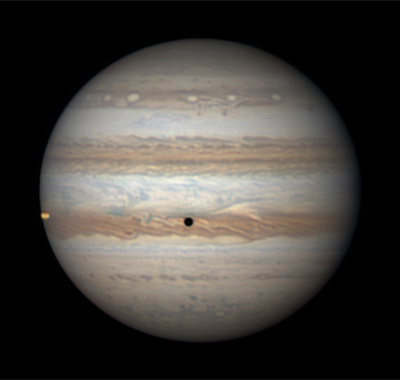
Mercury is hidden in conjunction with the Sun.
Venus is deep in the bright afterglow of sunset.
Mars (magnitude –1.4, in Libra) is now only Sirius-bright; it was closest to Earth on May 30th. It's the yellow-orange light in the south during and after dusk. Mars shrinks from 16 to 15 arcseconds in diameter this week, as Earth pulls ahead of it in our faster orbit around the Sun. See our telescopic guide to Mars in the April Sky & Telescope, page 48, or the version online. And set our Mars Profiler for your time and date.
Jupiter (magnitude –1.8, at the hind foot of Leo) is getting low in the west after dusk. It's on the far side of its orbit from us, 34 arcseconds wide, almost the smallest it ever appears.
Saturn (magnitude +0.2, in southern Ophiuchus) glows about 18° east (left) of Mars. To Saturn's lower right by 6° is Antares. Look near the middle of the long Mars-Saturn-Antares triangle for Delta Scorpii (Dschubba). See our telescopic guide to Saturn in the June Sky & Telescope, page 48.
Uranus (magnitude 5.8, in Pisces) and Neptune (magnitude 7.9, in Aquarius) are well placed in the southeastern sky before the first light of dawn. Background and finder charts.
__________________________
All descriptions that relate to your horizon — including the words up, down, right, and left — are written for the world's mid-northern latitudes. Descriptions that also depend on longitude (mainly Moon positions) are for North America.
Eastern Daylight Time (EDT) is Universal Time (UT, UTC, or GMT) minus 4 hours.
__________________________
“This adventure is made possible by generations of searchers strictly adhering to a simple set of rules. Test ideas by experiments and observations. Build on those ideas that pass the test. Reject the ones that fail. Follow the evidence wherever it leads, and question everything. Accept these terms, and the cosmos is yours.”
— Neil deGrasse Tyson
 0
0








Comments
You must be logged in to post a comment.